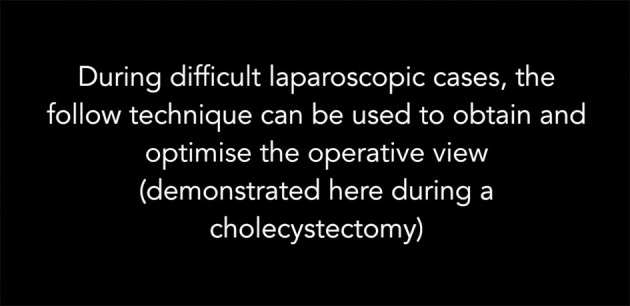Background
Recent years have seen a trend towards laparoscopy for many different procedures.1,2 Although the laparoscopic route confers several advantages, it can make surgery more technically challenging. Obtaining a good view with clear access to the operative field is vital. Multiple laparoscopic retraction techniques have been described, with many requiring constant manual input.3,4 We describe an inexpensive, adjustable method of laparoscopic retraction which, after setup, can be left ‘hands free’.
Technique
A small incision is made in the skin a short distance away from the operative site. A 5-mm port is introduced obliquely angled away from the site of interest. The port can then be turned towards the tissue to be retracted (this manoeuvre is against resistance) and a blunt pledget dissector placed. The port will try to revert to its original angle due to the elasticity of the abdominal wall. This places the blunt pledget dissector under tension, which provides constant retraction. The position of the blunt pledget dissector can be easily adjusted to maintain and optimise the operative view (Video 1).
Video 1.

A novel method of ‘hands-free’ laparoscopic retraction.
Discussion
This technique is simple to perform, requires only routine equipment and can greatly enhance the surgeon’s view and access in more complex cases (for example, patients who are obese ). It can be used across a wide range of laparoscopic procedures and frees up the operator. Use of a blunt instrument helps prevent injury of the retracted tissue. Although it requires placement of an additional port site, this is more than justified by increased intraoperative safety.
References
- 1.Eurostat Statistics Explained Surgical operations and procedures statistics. Luxembourg: Eurostat; 2017. http://ec.europa.eu/eurostat/statistics-explained/index.php/Surgical_operations_and_procedures_statistics (cited August 2018). [Google Scholar]
- 2.Richards MK, Mcateer JP, Drake FT et al. A national review of the frequency of minimally invasive surgery among general surgery residents: assessment of ACGME case logs during 2 decades of general surgery resident training. JAMA Surg 2015; (2): 169–172. [DOI] [PubMed] [Google Scholar]
- 3.Vargas-palacios A, Hulme C, Veale T, Downey CL. Systematic review of retraction devices for laparoscopic surgery. Surg Innov 2016; (1): 90–101. [DOI] [PubMed] [Google Scholar]
- 4.Ladwa N, Sajid MS, Pankhania NK et al. Retraction techniques in laparoscopic colorectal surgery: a literature-based review. Colorectal Dis 2013; (8): 936–943. [DOI] [PubMed] [Google Scholar]


